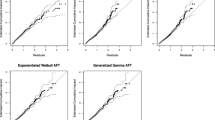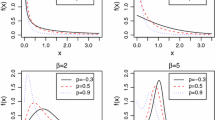Abstract
The Weibull, log-logistic and log-normal distributions are extensively used to model time-to-event data. The Weibull family accommodates only monotone hazard rates, whereas the log-logistic and log-normal are widely used to model unimodal hazard functions. The increasing availability of lifetime data with a wide range of characteristics motivate us to develop more flexible models that accommodate both monotone and nonmonotone hazard functions. One such model is the exponentiated Weibull distribution which not only accommodates monotone hazard functions but also allows for unimodal and bathtub shape hazard rates. This distribution has demonstrated considerable potential in univariate analysis of time-to-event data. However, the primary focus of many studies is rather on understanding the relationship between the time to the occurrence of an event and one or more covariates. This leads to a consideration of regression models that can be formulated in different ways in survival analysis. One such strategy involves formulating models for the accelerated failure time family of distributions. The most commonly used distributions serving this purpose are the Weibull, log-logistic and log-normal distributions. In this study, we show that the exponentiated Weibull distribution is closed under the accelerated failure time family. We then formulate a regression model based on the exponentiated Weibull distribution, and develop large sample theory for statistical inference. We also describe a Bayesian approach for inference. Two comparative studies based on real and simulated data sets reveal that the exponentiated Weibull regression can be valuable in adequately describing different types of time-to-event data.









Similar content being viewed by others
References
Aarset MV (1987) How to identify bathtub hazard rate. IEEE Trans Reliab R–36:106–108
Akaike H (1974) A new look at the statistical model identification. IEEE Trans Autom Control 19:716–723
Azzalini A, Capitanio A (2014) The skew-normal and related families. Cambridge University Press, New York
Burnham KP, Anderson DR (2002) Model selection and multimodel inference: a practical information-theoretic approach, 2nd edn. Springer, New York
Burr IW (1942) Cumulative frequency functions. Ann Math Stat 13:215–232
Cancho V, Bolfarine H, Achcar JA (1999) A Bayesian analysis for the exponentiated-Weibull distribution. J Appl Stat Sci 8:227–242
Cancho VG, Ortega EMM, Bolfarine H (2009) The log-exponentiated-Weibull regression models with cure rate: local influence and residual analysis. J Data Sci 7:433–458
Cox C, Matheson M (2014) A comparison of the generalized gamma and exponentiated Weibull distributions. Stat Med 33(21):3772–3780
Elal-Olivera D (2010) Alpha-skew-normal distribution. J Math Proyecc 29:224–240
Efron B (1974) Logistic regression, survival analysis, and the Kaplan-Meier curve. J Am Siat Assoc 83:414–425
Gilks WR, Richardson S, Spiegelhalter DJ (1996) Introducing Markov chain Monte Carlo. In: Gilks WR, Richardson S, Spiegelhalter D (eds) Markov Chain Monte Carlo in practice. CRC Press, Florida, pp 1–19
Hoel DG (1972) A representation of mortality data by competing risks. Biometrics 28:475–488
Kalbfleisch JD, Prentice RL (2002) The statistical analysis of failure time data. Wiley, New Jersey
Kaplan EL, Meier P (1958) Nonparametric estimation from incomplete observations. J Am stat Assoc 53(282):457–481
Kleiber C, Kotz S (2003) Statistical size distributions in economics and actuarial sciences. Wiley, New Jersey
Lai C-W (2014) Generalized Weibull distributions (SpringerBriefs in Statistics). Springer, New York
Lawless JF (2003) Statistical models and methods for lifetime data. Wiley, New York
McElroy T, Wildi M (2013) Multi-step-ahead estimation of time series models. Int J Forecast 29:378–394
Maechler M (2016) Rmpfr: R MPFR-Multiple precision floating-point reliable, R package version 0.6-1. Available at https://CRAN.R-project.org/package=Rmpfr
Mudholkar GS, Srivastava DK (1995) The exponentiated Weibull family: a reanalysis of the bus-motor-failure data. Technometrics 37(4):436–445
Nash JC (2014) On best practice optimization methods in R. J Stat Softw 60(2):1–14
Nash JC (2014) Nonlinear parameter optimization using R tools. Wiley, West Sussex
Pewsey A, Gómez HW, Bolfarine H (2012) Likelihood-based inference for power distributions. Test 21(4):775–789
Prentice (1973) Exponential survival with censoring and explanatory variables. Biometrika 60:279–288
R Core Team (2016) R: a language and environment for statistical computing. R Foundation for Statistical Computing, Vienna
Smith AFM, Roberts GO (1993) Bayesian computation via Gibbs sampler and related Markov Chain Monte Carlo methods. J R Stat Soc (Ser B) 55:3–23
Stacy EW (1962) A generalization of gamma distribution. Ann Math Stat 33:1187–1192
Acknowledgements
The author acknowledges the comments and suggestions of the editor and the reviewers. This work was partially supported by NSERC through Discovery Grant (#368532) to SA Khan, and the University of Saskatchewan through New Faculty Start-up Operating Fund to SA Khan.
Author information
Authors and Affiliations
Corresponding author
Electronic supplementary material
Below is the link to the electronic supplementary material.
Rights and permissions
About this article
Cite this article
Khan, S.A. Exponentiated Weibull regression for time-to-event data. Lifetime Data Anal 24, 328–354 (2018). https://doi.org/10.1007/s10985-017-9394-3
Received:
Accepted:
Published:
Issue Date:
DOI: https://doi.org/10.1007/s10985-017-9394-3




